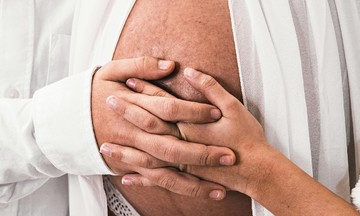In early July, 38-year-old Anh Giang and her husband traveled from Lao Cai to the Center for Reproductive Support at Tam Anh General Hospital in Hanoi to reunite with the doctors who helped them become parents. Their two children, born three years apart, are the "sweet fruit" of IVF.
Professor, Doctor Le Hoang, Director of IVF Tam Anh Hanoi, described Giang's case as one of the most challenging the hospital had handled. She experienced prolonged infertility due to multiple reproductive issues, including polycystic ovary syndrome (PCOS), a blocked left fallopian tube, and uterine adhesions.
PCOS is a leading cause of ovulatory dysfunction. Combined with blocked fallopian tubes and uterine adhesions, it significantly reduces the chances of natural conception, as eggs and sperm cannot meet, or the fertilized egg cannot implant.
Professor Hoang performed laparoscopic surgery to remove Giang's uterine adhesions and separate both fallopian tubes using a laparoscope and specialized instruments to restore the uterus's shape and function. After surgery, Giang underwent ovarian stimulation and IVF using her husband's sperm. However, the first embryo transfer was unsuccessful. The second resulted in an ectopic pregnancy, requiring emergency surgery to remove the affected fallopian tube. The third attempt led to a twin pregnancy, but unfortunately, she miscarried at 8 weeks.
The couple considered giving up, but Professor Hoang encouraged them to continue treatment. They underwent another IVF cycle, retrieving 7 embryos. Giang became pregnant with monochorionic-monoamniotic twins, where both fetuses share the same amniotic sac. One fetus was underdeveloped, but fortunately, the other remained healthy. Their first daughter was born in late 2020.
Three years later, the couple returned to IVF Tam Anh to try for another child. Examinations revealed that both fallopian tubes were completely blocked. They decided to use a frozen embryo from the previous IVF cycle. The embryo underwent pre-implantation genetic testing to minimize the risk of chromosomal abnormalities that could cause miscarriage. Giang successfully conceived and gave birth to a healthy son last year.
 |
Anh Giang and her husband’s two children were born thanks to IVF. Photo: Tam Anh General Hospital |
Anh Giang and her husband’s two children were born thanks to IVF. Photo: Tam Anh General Hospital
According to Professor Hoang, uterine and ovarian conditions are leading causes of female infertility. PCOS, diminished ovarian reserve, blocked fallopian tubes, endometriosis, ovarian cysts, and uterine issues like infections, adhesions, and polyps can all impact fertility. Cases like Giang's, with multiple conditions, are particularly complex to treat.
Laparoscopic surgery to address abnormalities combined with IVF is an effective approach that has helped many women with long-term infertility due to uterine and fallopian tube conditions become mothers. Professor Hoang advises women experiencing irregular periods, amenorrhea, severe menstrual cramps, difficulty conceiving after prolonged attempts, or pain during intercourse to seek early medical attention for timely treatment to avoid impacting their fertility.
Thanh Ba












